Kia ora to all Friends of the Wairoa River Catchment!
In this newsletter we have two stories – concerning ferrets (quite concerning), and concerning willows (contrastingly positive!).
Concerning Ferrets
Wairoa River catchment records for January…
- 8 ferrets trapped in one week on Lockwood Road. 9 ferrets from this property in total this month, and one stoat.
- 8 ferrets caught this month on Ponga Road – that we know about.
- 2 ferrets snagged on McGregor Road.
- 1 ferret ensnared in Paparimu.
- 1 ferret hit by a car on Papakura-Clevedon Road, one at the Hunua/Gelling Road intersection, and one at the Hunua/Heald Road intersection.
- 2 stoats trapped on Monument Road.
- Ferrets sighted across Hunua and Paparimu, and some in Clevedon, during January 2024.
- Mustelid sign, e.g. disappearing poultry, also reported across the catchment.
In conclusion… The catch numbers are high from just a few active trappers. The destruction caused by one of these animals is devastating. Do you have any catch data or sightings to add? Please email them in to us so that we can build a picture of where they are.
To get the better of this population we all need to do our bit – read on.
January and February are the best months for trapping mustelids (ferrets and stoats) as the young leave the dens in packs and are naive to the dangers that traps pose. At this stage, the young females will already be pregnant, so to trap them before they give birth is crucial. As they hang around in packs, you can often trap the entire litter within a week – as achieved by our trapper on Lockwood Road!
The best trap for successfully trapping mustelids is a double-ended live trap. These can be bought online, from predatorfreefranklin.nz or farming stores, or hired locally from Pet & Paddock in Clevedon. A double ended live trap has two open doors, one at either end, with a treadle in the middle that when triggered, closes both doors. This gives the illusion to predators entering the trap that it is safe and there is a way out (i.e. not a dead end). If live trapping isn’t your cup of tea, try a DoC200 or F-bomb trap (particularly useful for those who struggle with setting a DoC200).
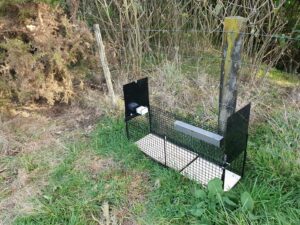
Place the trap in a sheltered place, next to a retaining wall or under a flax bush, or near the chicken run. Use fish skin, rabbit or possum meat, or some scraps from your dinner meat to bait the trap and lure them in – they are attracted to protein.
Once caught in a live trap, shooting is the most humane option to deal with the animal. A high-powered air rifle will do the trick and does not require a gun license, or a good relationship with a neighbour who has a license will help.
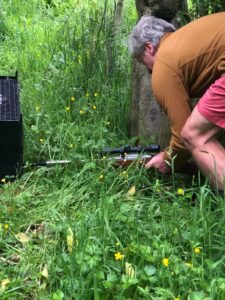
Once the deed is done, rub the body of the animal over the trap to transfer the scented oils and draw any other mustelids in the area into the trap. If you have a garage freezer, consider saving the body for research. Double bag the body, write on it the address it was caught at and the date, and pop it in the freezer. Contact us to arrange pickup or drop-off ASAP. The research will analyse DNA and other metrics to better understand the local populations, and thus devise better methods for eradicating them from Aotearoa.
And finally, don’t forget to send your catch data through to pestcontrol@tewairoa.org.nz or enter it into trap.nz. A massive thankyou to those who are regularly reporting catch tallies via the trap.nz app. You’re welcome to email any catch data since 1 July 2023 to me to upload on your behalf, so that we can ensure our records are as accurate as possible and reflect our work, and provide accountability to our funders who allow us to purchase predator control gear to distribute. It is vital to build a picture of what we are trapping and where, so that we can better support communities as a whole and continue to motivate each other in this marathon to get to Predator Free 2050.
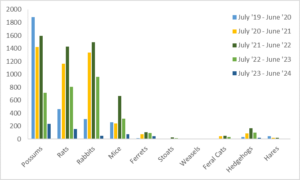
Concerning Willows: a personal story to start 2024.
With the crack willow eradication campaign well underway now, we thought it time to remove Willow’s willows (if you know, you know…). Our reasoning was two-fold – to lead by example, and to give the methods a shot and make sure we could make them work. So, just before Christmas my sister and I headed down the hill to the stream, armed with an electric drill and a 10mm drill bit, a spare battery, and some glyphosate, undiluted in a spray bottle labelled ‘TOXIN’, with the nozzle set to jet.
From the driveway looking down, it was easy to spot the lush green foliage of the willows in the stream. We made a beeline through the undergrowth towards them and found the culprits relatively easily. The problem they create was clear – these were old trees with multiple trunks. At some point, those trunks had weakened and split apart, yet continued growing. One tree had become five trees, and where the now horizontal trunks dipped into the soil, each connection had grown further roots. A willow that Willow had chopped into logs and left where they lay, had rooted from the logs and was ready to continue growing. See in the image below the healthy red willow roots growing on the trunk and infiltrating the stream sediment.
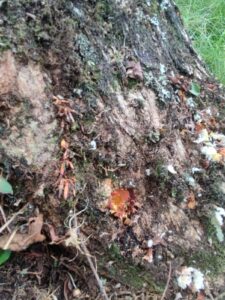
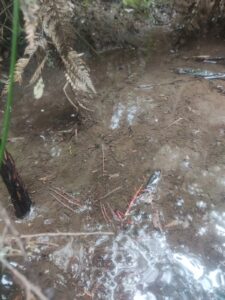
Upon finding the main trunk of a willow, Melle drilled a 5cm deep hole low down on a downwards angle and a little to the side, rather than straight into the core. I then followed with the spray bottle and filled the hole with glyphosate, being careful to spill as little as possible. We wanted to contain the toxin in the tree so that it’s use was targeted, as we were well aware any toxin is not something to take lightly in the environment. Melle would then drill the next hole a hand’s width from the last one, and I would fill that too until we had drilled and filled holes all around the trunk.
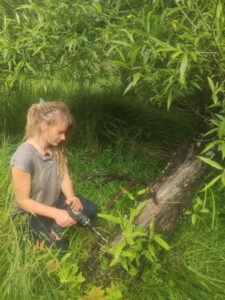
It took us about 1.5 hours to drill and fill 13 trees. The main delays were avoiding filling our gumboots with swamp water or ending up face down in it, and the drilling itself. We found that willows are quite soft, so the drill bit often got clogged and needed to be wiped clean once or twice for each hole we made. After a misjudged step, I did find myself on my backside at one point in a fit of giggles, but these moments make the experience fun and filled with memories, rather than a chore!
We found some neat pockets in amongst the willows on our bush bashing journey. At one point I looked up and found a very large clump of native orchids, Earina aestivalis, growing on a branch. Biodiversity is all around us, if we just keep our eyes peeled. And it’s worth protecting.
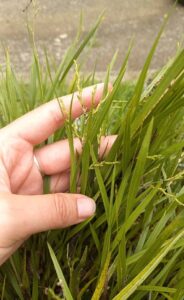
So now when you drive Hunua Road between Gelling Road and Paparimu, take note that the iconic Willow’s willows are dying or dead (see the yellow foliage in the image below). We’ll have to plant something else iconic in their place – maybe some kahikatea to hold the banks, since there’s some remnant forest further upstream!
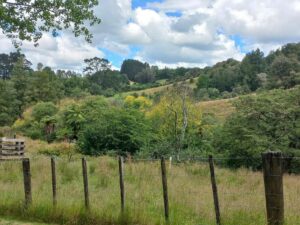
Watch this video for why we want to eradicate willows from the Wairoa River, and how to do it yourself. Next year, we hope to progress on the project and amp it up in scale, getting some further assistance for residents.
Upcoming events:
In 2024, we will be holding a volunteer/open day at the community nursery on the second Wednesday of each month from 8.30am – 10.30am. Find us on the right up the driveway next to Art Industry on the Clevedon main street.
- 14 February
- 13 March
- 10 April
- 8 May
- 12 June
- 10 July
- 14 August
- 11 September
- 9 October
- 13 November
- 11 December
The community nursery welcomes locals to come and purchase plants for their property, at $2 each. Contact info@tewairoa.org.nz to visit the nursery by appointment, or pop in during one of our open mornings.
Together, we are working towards restoring the mauri of the awa. We’d like to thank you all for your ongoing support of the mahi we do. It’s what keeps that ball rolling forward.
Happy trapping and planting,
Lenny van Heugten
Communications and Predator Control Co-ordinator
Friends of Te Wairoa
info@tewairoa.org.nz